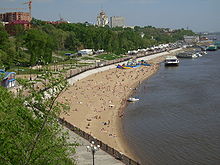 Flowing through the Northeast Asia for over 4444 kilometers (2.761 million), the mountains of northeastern China to the Sea of Okhotsk (near Nikolayevsk-na-Amur), drains a remarkable watershed includes a variety of desert landscapes , steppe, tundra, taiga, and finally emptying into the Pacific Ocean through the Strait of Tartary, at the mouth of the river from the northern tip of Sakhalin Island.
Flowing through the Northeast Asia for over 4444 kilometers (2.761 million), the mountains of northeastern China to the Sea of Okhotsk (near Nikolayevsk-na-Amur), drains a remarkable watershed includes a variety of desert landscapes , steppe, tundra, taiga, and finally emptying into the Pacific Ocean through the Strait of Tartary, at the mouth of the river from the northern tip of Sakhalin Island.Love has always been closely associated with the island of Sakhalin in his mouth, and most of the names of the island, even in the languages of indigenous peoples in the region derives from the name of the river: "Sakhalin" derives from a dialect related to the Tungus Manchu sahaliyan ("black" as in sahaliyan ula, "Black River"), while Ainu and Japanese "Karaputo" or "Karafuto" comes from the Ainu name of love or mouth. Anton Chekhov vividly described the Amur River in the writings about his trip to the island of Sakhalin in 1890.
The average annual flow varies from 6000 m³ / s (1980) - 12000 m³ / s (1957), which leads to an average of 9819 cubic meters / s or 310 km ³ per year. Most of the run-off took place on 1951 30700 m³ / s, while the lowest discharge recorded in March 1946 with only 514 m³ / s.
0 comments:
Post a Comment